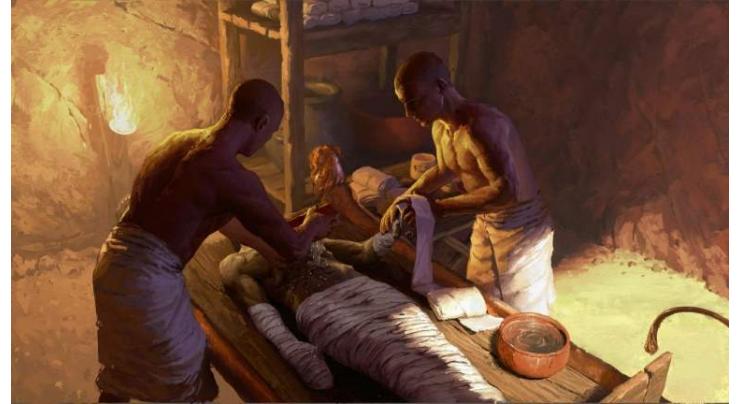
'Surprising' Ancient Egyptian Mummy Ingredients Discovered
Sumaira FH Published February 01, 2023 | 11:28 PM

The discovery of dozens of beakers and bowls in a mummification workshop has helped reveal how ancient Egyptians embalmed their dead, with some "surprising" ingredients imported from as far as Southeast Asia, a study said Wednesday
Paris, (APP - UrduPoint / Pakistan Point News - 1st Feb, 2023 ) :The discovery of dozens of beakers and bowls in a mummification workshop has helped reveal how ancient Egyptians embalmed their dead, with some "surprising" ingredients imported from as far as Southeast Asia, a study said Wednesday.
The exceptional collection of pottery, dating from around 664-525 BC, was found at the bottom of a 13-metre (42 feet) well at the Saqqara Necropolis south of Cairo in 2016.
Inside the vessels, researchers detected tree resin from Asia, cedar oil from Lebanon and bitumen from the Dead Sea, showing that global trade helped embalmers source the very best ingredients from across the world.
Ancient Egyptians developed a remarkably advanced process to embalm corpses, believing that if bodies were kept intact they would reach the afterlife.
The process took up to 70 days. It involved desiccating the body with natron salt, and evisceration -- removing the lungs, stomach, intestines and liver. The brain also came out.
Then the embalmers, accompanied by priests, washed the body and used a variety of substances to prevent it from decomposing.
But exactly how this was done has largely remained lost to time.
Now a team of researchers from Germany's Tuebingen and Munich universities in collaboration with the National Research Centre in Cairo has found some answers by analysing the residue in 31 ceramic vessels found at the Saqqara mummification workshop.
By comparing the residue to containers found in adjacent tombs, they were able to identify which chemicals were used.
The substances had "antifungal, anti-bacterial properties" which helped "preserve human tissues and reduce unpleasant smells," the study's lead author, Maxime Rageot, told a press conference.
Helpfully, the vessels have labels on them. "To wash," reads the label of one bowl, while another says: "to make his odour pleasant".
The head received the most care with three different concoctions -- one of which was labelled "to put on his head".
"We have known the Names of many of these embalming ingredients since ancient Egyptian writings were deciphered," Egyptologist Susanne Beck said in a statement from Tuebingen University.
"But until now, we could only guess at what substances were behind each name." The labels also helped Egyptologists clear up some confusion about the names of some of the substances.
The scant details we have about the mummification process mostly comes from ancient papyrus, with Greek authors such as Herodotus often filling in gaps.
By identifying the residue in their new bowls, the researchers found that the word "antiu", which has long been translated as myrrh or frankincense, can actually be a mixture of numerous different ingredients.
In Saqqara, the bowl labelled antiu was a blend of cedar oil, juniper or cypress oil and animal fats.
Related Topics
Recent Stories

Saudi Assistant Minister of Defence calls on army chief

Currency Rate In Pakistan - Dollar, Euro, Pound, Riyal Rates On 19 April 2024

Today Gold Rate in Pakistan 19 April 2024

Rock-solid Ruud racks up season-leading win in Barcelona

At UN, Iran says it will make Israel 'regret' reprisals

G7 hears calls for 'critical' Ukraine aid

EU seeks to leverage might to confront China, US challenge

5 Customs officials martyred as their vehicle ambushed by terrorists in D I Khan

Pak-New Zealand match called off due to rain

NHA restores traffic on roads affected by recent rains in Balochistan

China to fully support Pakistan's efforts against terrorism: Ambassador Jiang

U.S. envoy calls on Foreign Minister Ishaq Dar
More Stories From World
-
Alternate jurors to be confirmed at Trump trial
8 minutes ago -
Ambassador Munir Akram discusses issues on UN agenda with Iran's top diplomat
8 minutes ago -
New Zealand ram put down after death of elderly couple
18 minutes ago -
Three killed, 20 injured in Russian strikes on southern Ukraine
28 minutes ago -
Biden steps up campaign with Trump 'busy' in court
58 minutes ago -
US 'swatting' pranks stoke alarm in election year
58 minutes ago
-
US veto sinks Palestinian UN membership bid in Security Council
1 hour ago -
Duplantis to unleash 'inner' pole vault contest as Olympics beckon
2 hours ago -
Australia tells citizens to depart Israel, Palestinian territories if 'safe to do so'
2 hours ago -
Netflix beats expectations on profit and subscribers
2 hours ago -
US vetoes Palestinian request for full UN membership
2 hours ago -
Defending champion Swiatek motors into Stuttgart quarter-finals
2 hours ago